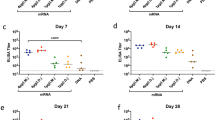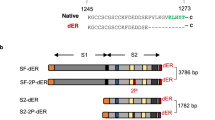Abstract
Measles remains a principal cause of worldwide mortality, in part because young infants cannot be immunized effectively. Development of new vaccines has been hindered by previous experience with a formalin-inactivated vaccine that predisposed to a severe form of disease (atypical measles). Here we have developed and tested potential DNA vaccines for immunogenicity, efficacy and safety in a rhesus macaque model of measles. DNA protected from challenge with wild-type measles virus. Protection correlated with levels of neutralizing antibody and not with cytotoxic T lymphocyte activity. There was no evidence in any group, including those receiving hemagglutinin-encoding DNA alone, of ‘priming’ for atypical measles.
This is a preview of subscription content, access via your institution
Access options
Subscribe to this journal
Receive 12 print issues and online access
$209.00 per year
only $17.42 per issue
Buy this article
- Purchase on Springer Link
- Instant access to full article PDF
Prices may be subject to local taxes which are calculated during checkout




Similar content being viewed by others
References
Albrecht, P., Ennis, F.A., Saltzman, E.J. & Krugman, S. Persistence of maternal antibody in infants beyond 12 months: Mechanism of measles vaccine failure. J. Pediatr. 91, 715–178 (1977).
Gans, H.A. et al. Deficiency of the humoral immune response to measles vaccine in infants immunized at age 6 months. J. Am. Med. Assoc. 280, 527–532 (1998).
Holt, E.A., Moulton, L.H., Siberry, G.K. & Halsey, N.A. Differential mortality by measles vaccine titer and sex. J. Infect. Dis. 168, 1087–1096 ( 1993).
Berry, S. et al. Comparison of high titer Edmonston-Zagreb, Biken-CAM and Schwarz measles vaccines in Peruvian infants. Ped. Infect. Dis. J. 11, 822–827 (1992).
Garenne, M., Leroy, O., Beau, J.-P. & Sene, I. Child mortality after high-titre measles vaccines:prospective study in Senegal. Lancet 338, 903–907 ( 1991).
Annunziato, D. et al. Atypical measles syndrome: Pathologic and serologic findings . Pediatrics 70, 203–209 (1982).
Nader, P.R., Horwitz, M.S. & Rousseau, J. Atypical exanthem following exposure to natural measles: Eleven cases in children previously inoculated with killed vaccine. J. Pediatr. 72, 22–28 ( 1968).
Fulginiti, V.A., Eller, J.J., Downie, A.W. & Kempe, C.H. Altered reactivity to measles virus: Atypical measles in children previously immunized with inactivated measles virus vaccines. J. Am. Med. Assoc. 202, 1075 (1967).
Norrby, E., Enders-Ruckle, G. & ter Meulen, V. Differences in the appearance of antibodies to structural components of measles virus after immunization with inactivated and live virus . J. Infect. Dis. 132, 262– 269 (1975).
Norrby, E. & Gollmar, Y. Identification of measles virus-specific hemolysis-inhibiting antibodies separate from hemagglutination-inhibiting antibodies. Infect. Immun. 11, 231– 239 (1975).
Merz, D.C., Scheid, A. & Choppin, P.W. Importance of antibodies to the fusion glycoprotein of paramyxoviruses in the prevention of spread of infection. J. Exp. Med. 151, 275–288 ( 1980).
Auwaerter, P.G. et al. Measles virus infection in rhesus macaques: Altered immune responses and comparison of the virulence of six different virus strains. J. Infect. Dis. 180, 950–958 (1999).
Polack, F.P. et al. Production of atypical measles in rhesus macaques: evidence for disease mediated by immune complex formation and eosinophils in the presence of fusion-inhibiting antibody. Nature Med. 5, 629–634 (1999).
Lodmell, D.L. et al. DNA immunization protects nonhuman primates against rabies virus. Nature Med. 4, 949– 952 (1998).
Yang, K. et al. Early studies on DNA-based immunizations for measles virus. Vaccine 15, 888–892 ( 1997).
Drillien, R. et al. Protection of mice from fatal measles encephalitis by vaccination with vaccinia virus recombinants encoding either the hemagglutinin or the fusion protein. Proc. Natl. Acad. Sci. USA 85, 1252–1256 (1988).
Giraudon, P. & Wild, T.F. Correlation between epitopes on hemagglutinin of measles virus and biological activities: passive protection by monoclonal antibodies is related to their hemagglutination inhibiting acitivity. Virology 144, 46–58 ( 1985).
Malvoisin, E. & Wild, F. Contribution of measles virus fusion protein in protective immunity: anti-F monoclonal antibodies neutralize virus infectivity and protect mice against challenge. J. Virol. 64, 5160–5162 (1990).
Chen, R.T. et al. Measles antibody: reevaluation of protective titers. J. Infect. Dis. 162, 1036–1042 (1990).
Damien, B., Huiss, S., Schneider, F. & Muller, C.P. Estimated susceptibility to asymptomatic secondary immune response against measles in late convalescent and vaccinated persons. J. Med. Virol. 56, 85–90 (1998).
Etchart, N., Buckland, R., Liu, M.A., Wild, T.F. & Kaiserlian, D. Class I-restricted CTL induction by mucosal immunization with naked DNA encoding measles virus haemagglutinin. J. Gen. Virol. 78, 1577–1580 ( 1997).
Fooks, A.R., Jeevarajah, D., Warnes, A., Wilkinson, G.W. & Clegg, J.C. Immunization of mice with plasmid DNA expressing the measles virus nucleoprotein gene. Viral Immunol. 9, 65–71 (1996 ).
Cardoso, A.I. et al. Measles virus DNA vaccination: antibody isotype is determined by the method of immunization and by the nature of both the antigen and the coimmunized antigen. J. Virol. 72, 2516– 2518 (1998).
Cardoso, A.I. et al. Immunization with plasmid DNA encoding for the measles virus hemagglutinin and nucleoprotein leads to humoral and cell-mediated immunity . Virology 225, 293–299 (1996).
Donnelly, J.J. et al. Preclinical efficacy of a prototype DNA vaccine: enhanced protection against antigenic drift in influenza virus. Nature Med. 1, 583–587 ( 1995).
Davis, H.L., McCluskie, M.J., Gerin, J.L. & Purcell, R.H. DNA vaccine for hepatitis B: evidence for immunogenicity in chimpanzees and comparison with other vaccines. Proc. Natl. Acad. Sci. USA 93, 7213–7218 (1996).
Robinson, H.L. et al. Neutralizing antibody-independent containment of immunodeficiency virus challenges by DNA priming and recombinant pox virus booster immunizations . Nature Med. 5, 526–534 (1999).
Condon, C., Watkins, S.C., Celluzzi, C.M., Thompson, K. & Falo, L.D. Jr. DNA-based immunization by in vivo transfection of dendritic cells. Nature Med. 2, 1122–1128 ( 1996).
Raz, E. et al. Intradermal gene immunization: the possible role of DNA uptake in the induction of cellular immunity to viruses. Proc. Nat. Acad. Sci. USA 91, 9519–9523 ( 1994).
Acknowledgements
This work was supported by research grant AI-35149 (D.E.G.), and training grants AI-07417 (A.V.) and AI-07541 (A.V.) from the National Institutes of Health and the Pasteur Mérieux Connaught Fellowship in Pediatrics (F.P.P.).
Author information
Authors and Affiliations
Corresponding author
Rights and permissions
About this article
Cite this article
Polack, F., Lee, S., Permar, S. et al. Successful DNA immunization against measles: Neutralizing antibody against either the hemagglutinin or fusion glycoprotein protects rhesus macaques without evidence of atypical measles. Nat Med 6, 776–781 (2000). https://doi.org/10.1038/77506
Received:
Accepted:
Issue Date:
DOI: https://doi.org/10.1038/77506
This article is cited by
-
Heterologous Prime–Boost Strategy to Immunize Very Young Infants against Measles: Pre-clinical Studies in Rhesus Macaques
Clinical Pharmacology & Therapeutics (2007)
-
Global measles elimination
Nature Reviews Microbiology (2006)
-
A role for nonprotective complement-fixing antibodies with low avidity for measles virus in atypical measles
Nature Medicine (2003)



